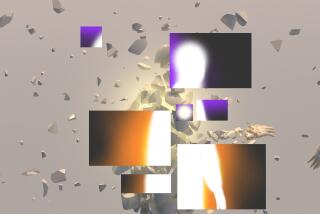Surveying the Landscape of Depression
- Share via
Exploring the anatomy of human melancholy, researchers have discovered that depression changes the shape of the brain.
Working with medical imaging devices that allow scientists to monitor mental activity, a researcher at the University of Pittsburgh Medical Center found for the first time that depressed patients lose substantial brain tissue in a specialized portion of the brain that helps control reactions to emotional experiences.
The region at risk is a thimble-sized area of the cerebral cortex linked to the severe depression that appears to have a strong grip on some families, generation after generation.
“We were trying to understand what brain regions were involved in mood disorders,” said Dr. Wayne C. Drevets, the principal investigator at the Pittsburgh medical center. “This is the first time anyone has actually shown an abnormality there [associated with] mood disorders.”
Collaborating with scientists at Washington University in St. Louis and the University of Iowa, Drevets pinpointed a critical nodule in the prefrontal lobe of the cerebral cortex that is both smaller and dramatically less active among clinically depressed patients than among nondepressed control subjects.
The difference in brain structure appeared only in those people whose depression seemed to be hereditary, and it persisted even after the mood disorder was brought under control with antidepressant drugs, the researchers reported recently in the journal Nature. In general, heredity plays a relatively small role in depression. However, experts said the finding adds an important link to the connections between mood disorders, the intangible mental functions of the human mind and the physical structure of the brain.
Although there are simply too many differences between individual brains for the new finding to be an effective diagnostic tool, it may help researchers better understand why some people can drown in waves of despair and hopelessness, while others can fight their way clear of dark, destructive moods. Mood disorders affect almost 20 million people. The study is the most recent in a series of discoveries in neuroscience bolstering the concept that mental illnesses, such as depression and schizophrenia, are problems arising from malfunctioning neural circuits in the brain.
The imaging study focused on a critical way station in the neural circuitry of emotion.
Previous studies have linked this part of the brain, called the subgenual prefrontal cortex, with the processing of emotions related to complex personal and social situations. It is part of an extensive network of neural circuits that control critical neurotransmitters such as dopamine, norepinephrine and serotonin, which are believed to play significant roles in regulating moods.
People who have suffered physical damage to this portion of the brain, as a result of strokes or head injuries, have difficulty responding to emotional experiences, frequently seem unusually angry or aggressive and are often unable to appreciate the consequences of their actions, medical experts said.
“They have identified a key player in one of the several systems that underlie emotional processing--a valuable finding indeed,” said Antonio Damasio, an authority on the neurobiology of emotion at the University of Iowa. “More importantly, it seems to be relevant for the kind of sustained emotion you find in abnormal moods such as depression or mania.
“This area receives inputs from a variety of areas of the brain and communicates its signals to other parts of the brain,” Damasio said. “There is a way for this area to intervene in many of the brain systems that alter emotion and act on emotion. It has a rather critical role to play because of who talks to it.”
In all, Drevets and his colleagues examined 49 men and women who had been diagnosed with major clinical depression. They also tested four manic patients.
The critical portion of the cortex was consistently underactivated among the depressed patients and overactivated among the manic patients.
*
The researchers used two noninvasive imaging techniques to chart the affected neural anatomy. They used positron emission tomography (PET) to track blood flow and metabolic activity in each patient’s brain and then used magnetic resonance imaging (MRI) to refine their findings.
In those people who had bipolar disorder--in which normal moods alternate with both depression and mania--the region of the cortex was 39% smaller than normal, and in those with the unipolar form of depression the area of the cortex was 48% smaller, the brain scans showed.
“Not only is the size of the area reduced, but the activity also is reduced,” said Dr. Marcus E. Raichle, a neurologist at the University of Washington Medical School who helped prepare the images. “This was the largest area of difference, but it was not the only one. This was part of a larger picture of the depressed brain.”
An earlier study showed similar shrinkage in a related portion of the brain called the amygdala, a cluster of cells located on both sides of the brain that is crucial in the creation of emotional memories.
The researchers are not yet sure whether the decrease in brain tissue and activity is caused by a problem in brain development or the area has atrophied as a consequence of repeated episodes of severe depression.
“One possibility is that this part of the brain never developed right and that this abnormality predisposes patients to developing these mood disorders,” Drevets said. “The other possibility is that this is a degenerative change caused by successive bouts of depression or mania.”
In order to resolve this question, the Pittsburgh group is now conducting brain studies of teenagers from families with a history of clinical depression. They hope to determine whether the area of the cortex is smaller in youths or whether it shrinks later in life.






